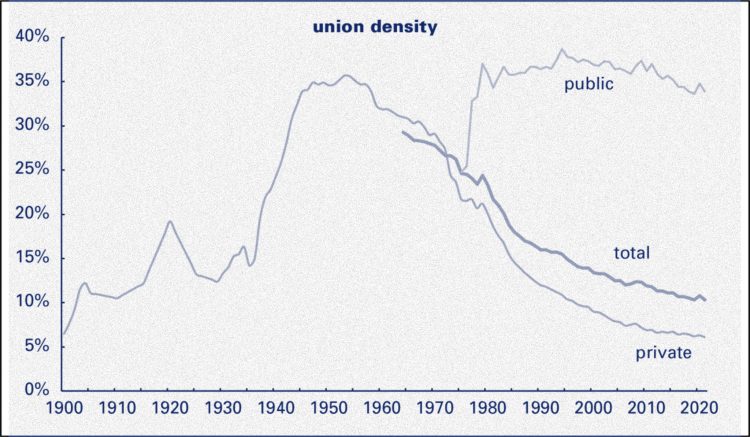Labor Movement Status and Recent Trends
By Colette Perold and Eric Dirnbach
Union Decline
The discussion of alternate forms of organizing has become increasingly urgent as the number of unionized workers has declined for decades.
The percentage of all workers who are union members, organized into traditional unions with union recognition and contracts, is called “union density” or the “union membership rate.” This figure peaked in the 1950s at about 35%. The number of total union members peaked in 1979 with about 21 million workers. These numbers have been falling for decades.
Beginning with the Reagan administration in the 1980s, the federal government aided the attack on organized labor through intense levels of union busting, the removal of regulations on corporations, and decades of conservative court decisions that made organizing and striking more difficult.
This is a result of the employers’ move to restructure tens of millions of jobs, including shifting work overseas or to non-union facilities, outsourcing work to domestic subcontractors, and misclassifying workers as independent contractors. Beginning with the Reagan administration in the 1980s, the federal government aided the attack on organized labor through intense levels of union busting, the removal of regulations on corporations, and decades of conservative court decisions that made organizing and striking more difficult.
A changing economy, corporate decisions, and union busting were then met on the labor side by a lack of success at large-scale organizing efforts, and an effort to pursue labor-management partnerships that often failed to deliver any benefits. This entire labor relations framework is extremely difficult to organize within on a large scale. Again and again, unions lobbied to pass labor law reform that would help penalize union-busting and enable more organizing, but all these efforts have failed.
Today, 14 million workers are union members, which is only about 10% of all workers.
Today, 14 million workers are union members, which is only about 10% of all workers. This chart above shows the union density over the last century, and more importantly, the decline since the 1950s. The private sector union density today is particularly alarming at only about 6%, similar to the early 1900s, while the public sector is about 34%. The percentage of workers covered by union contracts, which also includes workers who choose to not be union members but are in the bargaining unit, is slightly higher for all these numbers.
But More Workers Want Unions
This decline is not because workers don’t want unions anymore. Tens of millions of non-union workers approve of unions and want to join them. Gallup’s August 2022 poll of union approval shows public support for unions at 71%, the highest level since 1965.
Tens of millions of non-union workers approve of unions and want to join them.
For decades, surveys have shown that there is a tremendous “worker voice gap,” an unmet need for worker organizations. A recent survey shows that nearly 50% of non-union workers would vote for a union if they could. A 2021 survey found that “56% say the large reduction over the past several decades in the percentage of workers who are represented by unions has been “somewhat” or “very” bad for the country, while 60% say this has been bad for working people.” Another recent poll found strong support among workers for unions at their workplace, with the highest support from those who earn less than $25,000 per year (58%), between $25,000 and $50,000 per year (57%), and among people with less than a high school education (60%). More than half of lower income workers would support a strike at their job.
The challenge is to find ways of helping all these workers organize, while acknowledging that the traditional strategy through workplace elections has not been successful on a mass scale for a long time.
The challenge is to find ways of helping all these workers organize, while acknowledging that the traditional strategy through workplace elections has not been successful on a mass scale for a long time. The next sections discuss the traditional organizing approach and why it’s not reaching all the workers who want a union.


